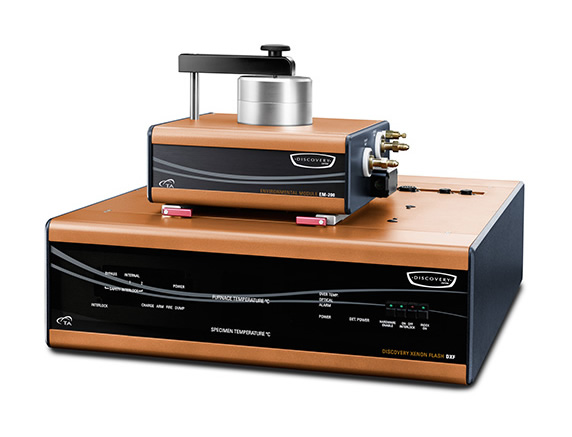
High speed Xenon-pulse delivery source and two pins contact detector for high sensitivity measurements also at very low temperature.
Sales PromotionsThe Discovery Xenon Flash DXF 200 employs a High Speed Xenon-pulse Delivery source (HSXD) with considerably lower cost and less maintenance than a laser and generates equivalent results. A reflective optic configuration of our design effectively harnesses the power of a Xenon flash tube and, with the aid of proprietary wave guides, delivers it to the specimen inside the Environmental Module. DXF 200 produces a pulse width that is shorter (400 μs to 600 μs) than many commercial laser-based systems, while uniformly concentrating sufficient power from the flash source directly on the entire face of the specimen. Due to this optimized optical arrangement and the broad light spectrum, specimens as large as 25 mm in diameter can be illuminated with sufficient energy to make a high-accuracy measurement. The use of large samples diminishes errors associated with inhomogeneity and permits representative measurements of poorly dispersed composites.
A sub-ambient test system, DXF 200 uses an efficient liquid nitrogen cooling mechanism to provide accurate and stable temperature control from -150 °C to 200 °C in air or inert gas.
At this temperature traditional IR detectors exhibit poor sensitivity at low temperatures. To overcome this limitation, the DXF 200 employs a solid-state detector that enables high-sensitivity measurements under cryogenic conditions.
Unparalleled Accuracy
Unparalleled Accuracy
All Discovery Flash source modules employ full-time pulse mapping and recording capability. This allows for precise pulse-shape and pulse-width correction calculations and the most accurate determination of the t0.
The Discovery Flash data analysis software also employs the latest methods for heat loss corrections. The Clark and Taylor and Curve Fitting algorithms are utilized as the most accurate general purpose procedure to determine thermal diffusivity based on the finite pulse width, radiation heat losses, and non-isothermal local sample conditions. Additionally, more than 20 different analysis models and correction programs are incorporated into the software, providing the highest accuracy for all material types.
Sensor Technology
Sensor Technology
The DXF 200 employs a proprietary solid-state PIN detector, providing unprecedented accuracy at room temperature and the ability to precisely measure the thermal diffusivity at temperature lower than any IR detector-based system. The signal-to-noise ratio for the solid-state PIN detector at -150°C is more than 5 times greater than for a traditional IR detector at room temperature.
Standard and Universal
Standard and Universal
The flash method is widely accepted and is documented in ASTM E1461, ASTM E2585, DIN EN821, DIN 30905, ISO 22007-4:2008, and ISO 18755:2005. All TA Instruments Discovery Flash instruments conform to these standards and can be relied on to produce accurate, repeatable results that can be easily compared between laboratories.



